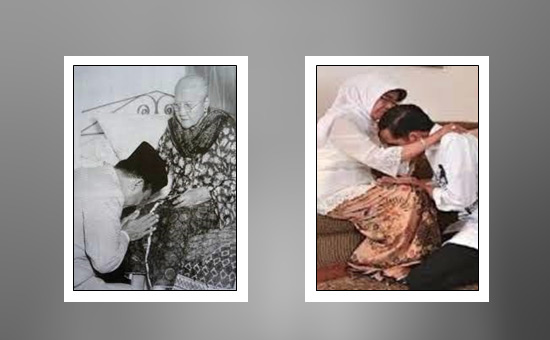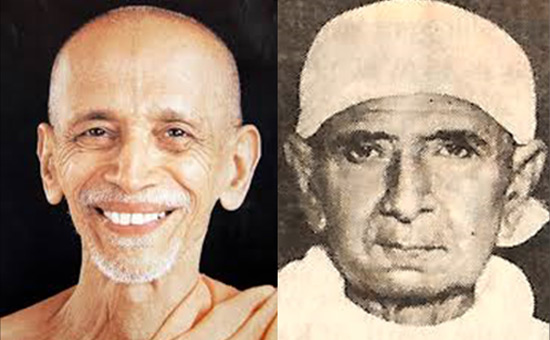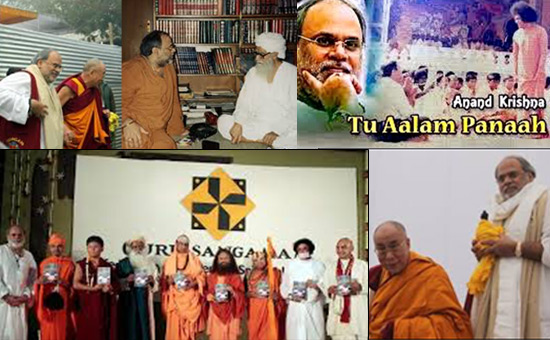-
On the occasion of
Guru Purnima the author offers tributes to the Gurus who made him what he is
today.
Guru Purnima is a Day for Reflection, a day to
meditate upon not only the meaning and the inner significance of both Guru
and Purnima, but also to offer our gratitude to all those who have
inspired and guided us along the path.
We all are familiar with the following opening verse
of the Guru Stotra in praise of the Guru:
Gurur Brahma Gurur Vishnu Gururdevo
Maheshvarah |
Gurur Sakshat Param Brahma Tasmai Shri Gurave
Namah ||
Guru is
the very Manifestation of Brahma, the Creator; Vishnu, the
Sustainer; and, Maheshvara or Shiva, the Recycler. Indeed, Guru
is The Para Brahman, the Supreme One. Salutations to That Guru.
But, for Those who have long forgotten their ancestral wisdom, culture or samskriti,
such praise, adulation or glorification of a “living being” can be considered
blasphemous.
We are not talking about those not familiar with our
traditions, but our own youth, our youngsters - they have a huge problem bowing
down to the elders. The television anchors in Bharat not only call their
elderly guests by name, but also shout and scream at them, forgetting the very
Ethics of Journalism. Namaskar and Namaste have lost their meaning. They are
used as lip service.
So, how can a Guru be The Very Manifestation of Para Brahma? How can parents be revered as the Embodiments of the Divine? Do we
still remember the dictum Matru, Pitru and Acharya Devo Bhava?
Revere your mother, your father, and your teacher, nay, even your guest, atithi
as the embodiments of the Divine.
Time to return to the above quote by Ramana Maharshi, part of a conversation between him and a disciple as documented by Arthur Osborne… here are some extracts:
Disciple:
Bhagavan says he has no disciples?
Bhagavan: Yes.
D: He
also says that a Guru is necessary if one wishes to attain Liberation?
Bhagavan: Yes.
D: What
then must I do? Has my sitting here all these years been just a waste of time?
Must I go and look for some Guru in order to receive initiation seeing that
Bhagavan says he is not a Guru?
Bhagavan: What do you
think brought you here such a long distance and made you remain so long? Why do
you doubt? If there had been any need to seek a Guru elsewhere you would have
gone away long ago.
D: Then
Bhagavan does have disciples!
Bhagavan: As I said, from Bhagavan’s point of view there are no disciples; but from that
of the disciple the Grace of the Guru is like an ocean. If he comes with a cup
he will only get a cupful. It is no use complaining of the niggardliness of the
ocean; the bigger the vessel the more he will be able to carry. It is entirely
up to him.
D: Then
to know whether Bhagavan is my Guru or not is just a matter of faith, if
Bhagavan will not admit it.
Bhagavan (humorously): Ask him, does he want me to give him a written
document?
I was not Fortunate Enough to be blessed in person by Shri Bhagavan, not physically by the form
that was His, but blessed to have met Gurus like him. Gurus who were above
elaborate initiation and empowerment ceremonies, and had no business with
certificates and certifications. That is, “no written documents” in the
words of Ramana Maharshi.
My First Gurus were my Parents. My mother was a
simple woman. Her literacy skill was limited to signing her own name in Sindhi,
whereas my father was an avid reader. His library shared the same room with the
family altar for daily worship.
I was born in Surakarta, Central Java - not a very big city, but an important one - a city of royalties, where ancestral values mattered. Here they showed their respect to their parents by offering sungkem - bowing
down to them.
 Pranams to mother. Sourced from Net.
Pranams to mother. Sourced from Net.
The Tradition Lives on, the
ancient values are still held in high esteem by many. Look at the pictures above
- the first one is of President Soekarno, one of the Founding Fathers of the
modern Indonesian Republic, and the other one is of the current Head of State,
President Joko Widodo.
Coming back to my Gurus…
My
Father, Baba as my sister and I would call him in the Sindhi fashion,
was a warrior. I saw him falling to the lowest ebb, financially and socially,
but he never gave up. As the legendary phoenix he rose again from his own
ashes.
This lesson given by him has helped me repeatedly in
my own life. Every time I was in distress or facing hardship I would simply
look at his picture, and got infused with his energy!
An Ardent Devotee of Thakur, Sri Ramakrishna Paramahansa, he firmly believed in what the Great
Master said: Yato Mat - Tato Path.
Commonly
translated as "As many faiths, so many paths”, he interpreted the
phrase quite differently:
“Mat is not the same as faith, mat can be an
opinion, a perception. As per my understanding, Thakur was not referring to faith,
but to ‘the way people understand, the way we perceive, the way we interpret
our faith.”
“So, to me Yato Mat - Tato Path means: As many ways of understanding there are, as many opinions and perceptions there are, so many paths there are.”
With passage of time I understood him better. After his
demise - I wrote extensively on the subject. His interpretation continues to
light my path!
Mummy, as We Called our Mother - so as not to confuse her with our Grandmother who
was called Amma in the Sindhi Fashion - had an incredible power of
memory. She could recall all the stories and events from the immortal epics
Ramayana and Mahabharata. Well, actually any story from the scriptures. Once
heard, the stories became part of her memory bank.
On the other hand not only did she forgive her
offenders but also forgot their offences. It was so very easy to her, and came
about quite naturally.
On weekday evenings she invited all the Indian ladies
in the neighborhood for satsang. My sister would read out a passage from one of the
scriptures, and they would discuss the same. It was like a study circle. In
between, there would be bhajans, light dancing in the Sindhi Bhagat
style. For her religion was never a serious affair and spirituality was about
singing and dancing.
Now, Why Weekdays Only? Because Sunday evenings were reserved for family outing. In those days Saturday
was still considered a weekday, so six evenings a week for satsang and
one evening for family-sang - hahahaha!
When we were travelling, invariably within Indonesia, the satsang would
accompany us. I do not remember staying in a hotel because there were friends
with whom we stayed. And, they would stay with us when visiting Surakarta.
They, those family friends, shared the same interest.
So, bhajans and satsang
would continue. In fact, the Sunday evening outing would change into satsang
gathering during such outings.
During such gatherings, my father would share from the
books he read including Sufistic poetries of Sindhi Saints like Latif, Sachal,
and Sami. A sample:
"Wave is no different from the sea…Creation lives within the Creator, and Creator within creation…” Chanrai Bachumal Shikarpuri popularly known as SAMI (1743-1850).
Thus, my First Gurus: My Parents.
In 1965 we moved to Lucknow where we lived for a little over 5 years. Much of the events have been recorded in my autobiography, “Soul Quest: The Journey
from Death to Immortality”.
It was in Lucknow where I met an ice vendor whose real
name was unknown. Some called him Sheikh Baba out of sincere reverence whilst
others considered him a charlatan in the garb of an ice vendor posing as Baba.
Yet some others rejected him outright as an infidel for he would quote shlokas from
Gita with the same passion and reverence as the Quranic ayats.
He nurtured the sapling of love and compassion within
me, the seeds for which were sown by my parents and first Gurus. I saw embodied
within him the same spirit of Ramakrishna, the Great Master, albeit unknown to
anyone outside the lane where he lived.
Four years after we bade farewell to each other I returned to Lucknow in 1975 and visited the
same lane where he lived. Everything was the same, but he was no longer living
there.
Some of the neighbors told me that he had gone to his
home village and died there. Others were sure that he was alive but, kahin pahaad vahaad par chalaa gayaa, thodaa sanki to thaa hi (he has gone to the mountains, implicitly referring to
the Himalayas, he was a little mad anyway.) None could give me his address.
I was left with some memories, some teachings of such
a revolutionary nature that even to this day I dare not pen them down….
“The Letter A is for …..; but it can also be for…..; the meanings of those two words are distance apart…. Yet, A remains A. Without A, those words have no existence. But, A can exist without those words.”
Sufi? The
message of Gita simplified? Pure Vedanta, the essence of the Vedic
wisdom? The Ice Vendor Baba despised such debate: “Go to Aminabad (then one of the main markets in Lucknow) get yourself some kulfi falooda
(homemade ice cream served with vermicelli). Eat it, taste it for yourself.
What is the use of discussing, what is kulfi and what is falooda?”
He was my Second Guru.
Back to Jakarta around 1971 I was blessed by the presence of Swami
Chidananda Saraswati, the then President Swami of the Divine Life
Society and the renowned Sindhi Saint
Swami Lilashah.
 Swami Chidanand Saraswati and Swami Lilashah. Sourced from net.
Swami Chidanand Saraswati and Swami Lilashah. Sourced from net.
I attended every session of theirs, morning and
evening, must be more than a week where I was exposed to the subtleties of
Yoga, the Yogic practices, and the basic
principles of Ayurveda.
Theirs was a unique way of teaching. While making us
do different postures of Hatha Yoga, Swami Chidananda would also be talking
about Vedanta, about both the Upanishads and the Puranas. In those, rather
informal talks than formal discourses, the Non-Dualistic philosophy of Advaita and the Dvaita
or Dualistic base of the Puranas intertwined, intermingled so harmoniously and
naturally.
I Vividly Remember Swami Chidananda telling me in a more intimate interaction after one of
the sessions: “Asanas will make your body fit, your mind
clear and sharp - so you can use them to serve others.”
A similar message was given by Swami Lilashah: “Eating, drinking, sleeping - all these are necessary
for the body. But, too much of any of them will destroy your body. Instead of
pleasure, you will invite pain. So, discipline yourself. Moderation is important in everything.”
“You must also know
that true happiness (Ananda) is not the result of eating, drinking,
sleeping, and hoarding wealth. You can only experience true happiness when you
serve the poor, they needy.”
Ishwar ki kripa se, during 1971 to 1991, was blessed to have personal interactions with several
masters, genuine Sadgurus. To name a few of them: J. Krishnamurti, Acharya
Rajneesh, Sri Sathya Sai Baba, Swami Chinmayananda, Maharshi Mahesh Yogi. And
many other lesser known, yet highly evolved ones, not to mention some
mysterious Siddhas!
 With highly respected Gurus. Pic by author.
With highly respected Gurus. Pic by author.
It was those meetings, interactions and teachings that
ferried me across the rough seas of fear, anxiety, and worry when in 1991, I
was dying of Leukemia.
Someone once asked me, “Who among them would you consider as your Guru?” A difficult question,
for all of them contributed to the making of who I am today. Having said that,
following the age old Tibetan tradition, if I were to mention one name as my Moola Guru, then it would be Sri Sathya
Sai Baba.
He said, “But he was a charlatan, he fooled people and a Pedophile." I asked, “Did you ever meet him?” “Why should I, All Those Stories are everywhere!” And, his understanding of "everywhere” meant searching on the net.
I replied, “My experience with him is my own experience, having met and personally interacted with him several times. I choose to believe, to trust my own experience….”
Where do we find such a Guru nowadays?
Guru, a genuine Guru, a Sadguru is extolled as the One who Dispels the
darkness of delusion and ignorance. Purnima symbolizes the enlightenment that a disciple attains as the clouds of delusion and
ignorance disperse.
Having done all that, having guided
us all the way, the Guru, Sri Sathya Sai Baba says: "The Master is Your Heart,” meaning our Inner Heart, and he
adds, "Follow the Master” - meaning "follow the Inner Voice for that is the Voice of God.”
About the Author - Proud of his
Sindhi-Indian ancestry rooted in the Glorious Sindhu
Civilization and Culture Anand Krishna was born in Solo (Central Java),
and is his Karma Bhumi, his work field. Beside the mother Organization,
Anand Ashram Foundation (affiliated with UN), Anand Krishna has inspired
several other social and educational institutions. The 4th President of
Indonesia, KH Abdurrahman Wahid recognized his contributions and
said, “If we want to have peace, then we must hear what Anand Krishna is
saying”. He has a legacy of 180+ books to date with more than 1.5 million
copies sold in the past 20 years. Anandji has an ashram in Ubud, Bali.